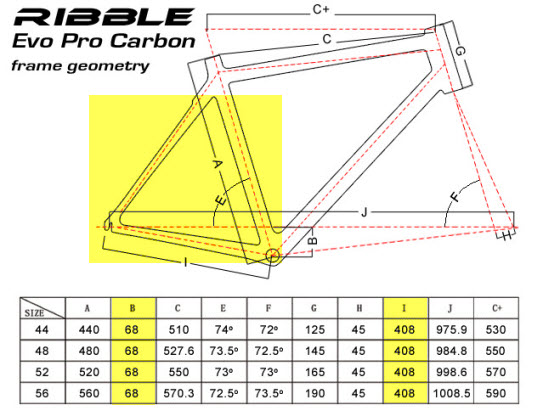Comment from Myth #4 Indoor Cycles require a lot of Fore/Aft Saddle adjustment to accommodate the range of cyclists coming into your class.
Well… the difference between real bikes and an IC bikes is that real bikes come in many frame sizes/geometries. They don”™t need much room for saddle fore/aft positioning because if you have the right size frame, you don”™t need that much fore/aft movement to find the right fit.
I should have anticipated this response and addressed it in my original post.
Changes in saddle Fore/Aft on an Indoor Cycle replicate the similar movement you would experience on various sizes of a typical road bicycle.
Let me explain...
I found this frame sizing chart at ribblecycles.co.uk and it's typical of most any modern road bicycle frame design sold in stock sizes.

Areas in yellow don't change, regardless of frame size
Certain dimensions* at the rear of a bicycle do not change with frame size:
- Dimension [B] is Bottom Bracket Height = how far the horizontal center-line of the Bottom Bracket is off the ground.
- Chain Stay length [I] sets the distance the rear wheel axle is from the vertical center-line of the Bottom Bracket
Changes in frame sizes come primarily from:
- Seat Tube length [A] affects saddle / stand-over height and is the most common method of sizing bicycles
- Top Tube length [C] changes the reach to the handlebars.
So with the back of the bicycle essentially unchangeable, if you want to increase the frame size you're limited to; make it taller or longer... but only through increasing the length of the Top Tube.**
Notice that there's no dimension for Saddle Post position Fore/Aft. That's because it's controlled by the Seat Tube Angle [E] which is near universally @ ~ 73° plus/minus on Road Bikes.*** Lengthen the Seat Tube and Saddle Post naturally moves further behind the Bottom Bracket center-line.
Indoor Cycles use a similar Seat Tube Angle = similar results. Raising the saddle also moves it toward the rear ~ the same amount as you would experience with bicycle frames in various sizes.
------------------------------------------------------------------------
*Yes, of course you can find examples in the extreme (very tall or short) where this isn't the case. I'm trying to make the point that bicycle manufacturers (indoor and out) design their products to fit 90+% of the general public, and, with over 100 years of experience, do so very effectively.
** Which is what Keiser attempts to do on the M3's handlebars. They move farther away, as you raise them up.
*** Triathlon Bikes for example, use a steeper (more vertical) Seat Tube Angle.

But you still have a lot more latitude for making fit adjustments on a “real” bike. There are differences in top tube length and reach (C) from various manufacturers, and that variable can be further fine tuned by using a longer or shorter stem, adding or removing spacers, etc., depending on the rider’s anatomy. You can also make much finer adjustments in saddle height, and can adjust variables like crank arm length, etc. to find the perfect fit. On an indoor bike, there’s only so much we can play with – you can adjust effective “top tube” length a little bit by moving saddle and handlebars up or down, but really, saddle height is the one variable I don’t want to mess with too much…. So if saddle height is set at the appropriate height for the rider’s anatomy (slight bend at the knee), and their reach is off or their center of gravity is to far forward or back, the only thing we have left to adjust is saddle (and handle bar on some bikes) fore/aft position…
p.s. One thing I forgot to add…. You will particularly notice differences in top tube/reach length when you look at the difference in geometry for “women’s specific” frames. Many of us ladies have proportionally shorter torsos than you men… That often leaves us feeling stretched out on a men’s frame (obviously that varies from person to person). Many of our riders are women, and I think many of them often look pretty stretched out on IC bikes… Once again, the only way to bring saddle and handle bars closer to reduce the reach is that saddle/handle bar fore aft thing…
Jennifer good points – Amy rides a Women specific Trek that goes beyond just a shorter top tube and uses 650 wheels which allows the entire bicycle to be proportionally smaller.
You’re right that conventional IC’s (without Fore/Aft adjustable handlebars) don’t leave you with any choice but slide the saddle forward.